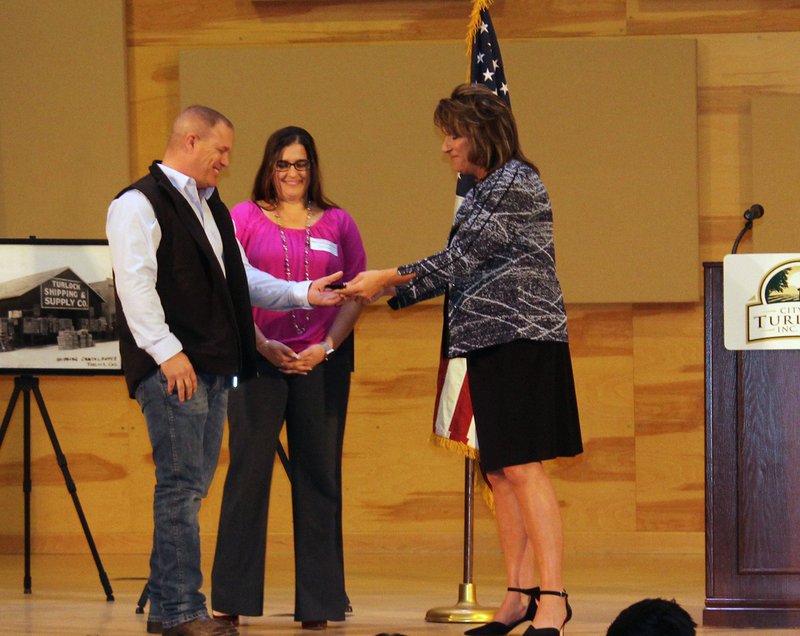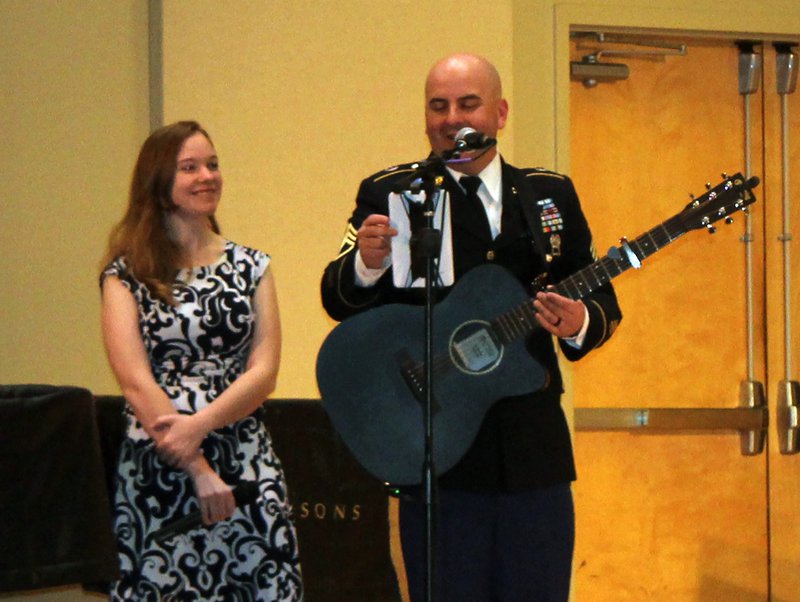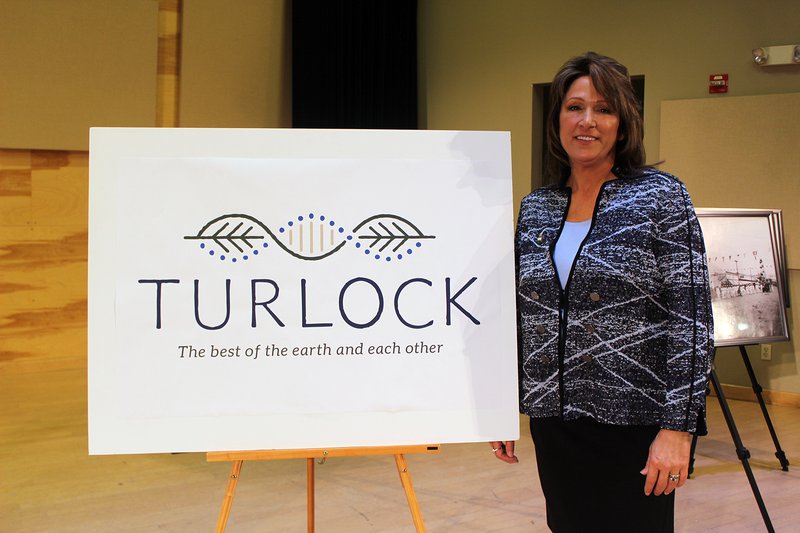In her first State of the City address, Turlock Mayor Amy Bublak highlighted successes over the past year while touching on key issues impacting the City including financial stability, water, roads, economic development, homelessness, public safety and volunteerism.
The Mayor also took the opportunity at the public event, held Thursday at Stanislaus State, to unveil a new logo and motto for the City, create a new award to honor exemplary citizens and present a key to the city to a local humanitarian.
“Turlock, like many communities across California and the nation, faces many challenges today, some we inherited and others we openly take responsibility for and are expected to start solving. The single greatest task is addressing the challenges we face to our community honestly and openly. Our job, my job, is to present the path forward. As your mayor, I work with my colleagues on the City Council to find ways to reach consensus on most of the most pressing issues,” said Bublak.
“Balancing the budget and restoring fiscal responsibility, while regaining the trust of our residents, remains my top priority as your mayor,” she continued.
Bublak said she and her colleagues were able to stop the previous practice of deficit spending by reducing the City’s operating budget by over $4 million and implementing a balanced budget. She also pointed to the recent adoption of a new public employee healthcare plan that sees City workers paying more out of pocket for their medical care.
Along with cutting expenses, the Mayor talked about avenues of bringing more revenue to City coffers.
She thanked Assistant to the City Manager for Economic Development and Housing Maryn Pitt for her efforts in bringing businesses to Turlock and talked about a group of local mayors who are working together to recoup more of the property tax dollars coming from their respective communities.
“Much of your property tax that is collected by the City does not stay in Turlock. This is unacceptable. It’s why I’m fighting for a more equitable solution, that will not unduly burden county government, but help our city government provide some of the essential City services our residents expect and deserve,” said Bublak.
When it comes to water — and the surface water treatment plant that is currently in the works — Mayor Bublak said she will continue to involve herself “in all aspects” of the project by seeking guidance from the Turlock and Modesto irrigation districts regarding how best to meet Turlock’s water needs and “directing our water experts to develop more cost-effective alternatives to the water plant such as rehabilitating our water wells or recruiting new water plant partners.”

She also said she would be directing City staff to look again into purchasing treated water from the MID surface water treatment plant.
“I promised the citizens of Turlock that I would do everything possible to limit their water rate increases as they relate to the SRWA (Stanislaus Regional Water Authority) project. While the cost has been lowered for the project, I still want to make sure we do everything possible to provide Turlock residents, farmers and businesses with safe, affordable water,” said Bublak.
Bublak went on to highlight the recent progress the City Council has made with improving Turlock’s roadways, specifically with changes in how utilities and others are required to patch roads and adopting a roads strategy that puts a priority on neighborhoods streets rather than main corridors.
“This is positive, but we must do more,” said Bublak, adding that the City and residents will need to have an “honest conversation” about what funding options are available to fix local roads.
Bublak went on to tout the lowered unemployment rate in Turlock over the past couple of years and recent retail, housing and industrial developments.
When it comes to homelessness, the Mayor said the City will continue to work with Stanislaus County, nonprofit agencies and local businesses to find solutions.
“It will take all of us working together to take care of this vulnerable population. This is a priority for our Council this year,” she said.
The Mayor also touched on the serious budget cuts to Turlock’s public safety departments.
“We know this situation is not sustainable as we look at this year’s budget. Communities like Turlock, Ceres, Keyes and others must explore strategies that will allow each community to leverage its financial resources as effectively as possible,” said Bublak.
The Mayor took the opportunity to applaud the local U.S. Army Recruitment office and other organizations that stepped up to adopt a Turlock park and also encouraged other residents to volunteer their time to make the community better.
According to Bublak, the good works of Turlockers and the stories of residents like Turlock Junior High student Michael Valdez who turned a bad experience into a movement against bullying, inspired her to create a new award.

“Based on our history as being known as the ‘heart of the Valley,’ I would like to announce my intent — with the support of my Council — to create the Heart of Turlock award. This award will be given annually to citizens of Turlock who perform exemplary acts of grace, justice and kindness, just like Michael and his mom did,” she said.
Along the Heart of Turlock award, Bublak also presented a new logo and motto for the City — Turlock: The best of the earth and each other.
The unveiling of the new motto for Turlock was followed by a musical performance from Staff Sergeant Jeremy Levens. The Army recruiter said when he came to Turlock four years ago, he had a vision of what living in California would be like. He said he was glad he was wrong.
“This song is kind of the heart of what Turlock’s been to me this time that I’ve been here,” he said.
The song was an ode to Turlock and mentions its high schools and popular roadways.
Along with being the first State of the City address for Mayor Bublak, Thursday was also the first time she has presented a key to the city. This symbolic gesture was given to Letters to Santa Charity founder and Turlock resident Justin Crone.
“On behalf of our City and our Council, we really appreciate what you have done, you and your family have been so special to so many people that otherwise wouldn’t have a Christmas…that they have great memories of and that’s so important to Turlock,” said Bublak.
The charity, now in its 11th year, has grown exponentially helping to provide 2,137 students with not only gifts that include a new coat, shoes, socks, underwear, pants, a shirt and a toy, but also contribute to a turkey dinner for their families.
In total, 720 families were helped by the charity 2019. There were 700 children in Turlock who benefitted from Letters to Santa, including students from Julien, Wakefield Elementary School, Cunningham Elementary School, Crowell Elementary School and Dennis Earl Elementary School.
In addition to the students helped each year, Letters to Santa also identifies a family in need who may benefit from a bit of extra help. Last year, the organization helped a homeless Turlock family find housing when they were living in their car.
Letters to Santa raises funds each year through both a golf tournament and dinner.

“Eleven years ago, we came up with this crazy idea at the time to try and give back a little. Long story short, we raised $7,600 that year and helped about 65 kids and we thought we were doing something pretty great. And then this great community stood behind us and wanted us to do more — so we kept doing more. So, year one was $7,600, this year we made about $290,000…I have a really special board of directors that I couldn’t do this without and through the years it’s gotten bigger and bigger and bigger,” said Crone.
For video coverage of the State of the City address, visit TurlockJournal.com.









